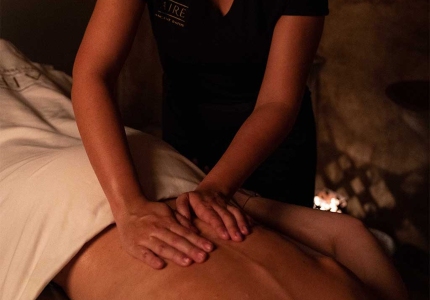Millions of people worldwide suffer with sciatica, a condition marked by sciatic nerve pathway radiating pain, numbness, and tingling that impairs general well-being and interferes with daily living. Among the difficulties this illness presents, massage therapy shows up as a safe, all-natural way to relieve sciatic nerve pain and encourage recovery. In this article, we'll examine the methods and advantages of sciatica massage therapy and how it can provide relaxation and relief to people suffering from sciatic pain.
Understanding Sciatica, Its Causes, and Impact
Many underlying conditions can cause sciatica, such as spinal stenosis, herniated discs, or compression of the sciatic nerve from tension or injury in the muscles. The symptoms that follow, which can range from sharp shooting pain to weakness and numbness in the legs, buttocks, and lower back, severely impacting one's quality of life by making daily tasks difficult and reducing mobility and comfort.
The Benefits of Massage for Sciatica
For those with sciatica, a sciatica massage has several therapeutic advantages. Massages are a useful tool for reducing sciatica pain and discomfort because they target muscle tension and inflammation. Increased blood flow to the injured area through improved circulation aids in healing, and relaxed muscles reduce stress and increase flexibility, allowing for greater comfort and movement. Furthermore, massages relieve the mental and emotional pressure that frequently accompanies sciatic nerve pain, offering much-needed stress alleviation.
Techniques Used in Sciatica Massage
Using specialised sciatica massage techniques designed to relieve this condition is essential to addressing the underlying reasons of pain.
Deep Tissue Massage
By addressing underlying muscle tension and knots, deep tissue massage helps to relieve tension and encourage relaxation.
Trigger Point Therapy
By locating and releasing trigger points along the sciatic nerve system, trigger point therapy offers focused pain relief in particular locations.
Swedish Massage
Swedish massage offers overall relaxation and circulation benefits, enhancing the overall efficacy of the massage session.
Streching techniques
Stretching techniques increase flexibility and lessen nerve compression, which may result in increased mobility and reduced pain.
The Role of Aromatherapy in Sciatica Massage
For sciatica sufferers, adding aromatherapy to massage therapy improves the therapeutic outcome even more. To enhance the therapeutic benefits of massages, add essential oils like eucalyptus, lavender, or peppermint that are well-known for their anti-inflammatory and pain-relieving qualities. In addition to encouraging physical relaxation, aromatherapy also cultivates a feeling of peace and wellbeing. When combined with massage therapy, this results in holistic relief from sciatic discomfort.
Preparing for a Sciatica Massage Session
People can make the most of their sciatica massage experience by being well-prepared beforehand.
Consultation with the Therapist
Speaking with the therapist in person enables you to discuss particular symptoms, issues, and objectives, guaranteeing a customised treatment plan.
Comfortable Attire
Putting on loose, comfortable clothing makes it easier to reach the places that need massaging.
Communication with the Therapist
Good communication with the therapist during the session allows pressure and technique modifications to be made in accordance with each person's comfort level, which improves the massage's overall effectiveness.
What to Expect During a Sciatica Massage
In order to relieve pain and encourage relaxation, the sciatica massage therapist concentrates on the lower back, buttocks, and legs as the primary regions of discomfort. A customised and comfortable experience is ensured by adjusting the pressure and intensity of the massage based on each person's tolerance and preferences. In order to ensure that each client's requirements are met during the session, open communication with the therapist facilitates real-time feedback and modifications, building trust and a collaborative environment.
Post-Sciatica Massage Care
Making the most of a sciatica massage goes beyond the actual treatment. Long-lasting comfort and healing are facilitated by post-massage care practices.
Hydration
Drinking water keeps the body hydrated and aids in the removal of toxins, which promotes the body's natural healing processes.
Gentle Movement
Mild stretches and other forms of gentle exercise assist preserve flexibility and relaxation, which keeps the muscles from tensing up again.
Rest and Relaxation
Scheduling downtime for rest and relaxation amplifies the benefits of the massage and promotes general comfort and well-being.
Incorporating Sciatica Massage into Regular Wellness Practices
For long-term management of sciatic nerve pain, including sciatica massage into your normal wellness regimen is helpful. Understanding the frequency and timing of massage sessions with the help of a health professional ensures consistent relief and promotes ongoing healing. In managing sciatic nerve discomfort, it's crucial to recognize the integral role of self-care and holistic well-being. By nurturing our bodies and minds through practices like mindfulness, gentle movement, and nourishing nutrition, we not only alleviate immediate symptoms but also foster long-term resilience and overall wellness.
People suffering from sciatic nerve pain can find comfort and recovery through a customised and therapeutic approach with sciatica massage. People can enjoy deep relief and enhanced wellbeing using specialised techniques, aromatherapy, and post-massage care procedures. By incorporating sciatica massage into a regular wellness routine, individuals can proactively manage their symptoms and reclaim control over their lives, helping them destressing during daily life while fostering a renewed sense of comfort, mobility, and vitality.



